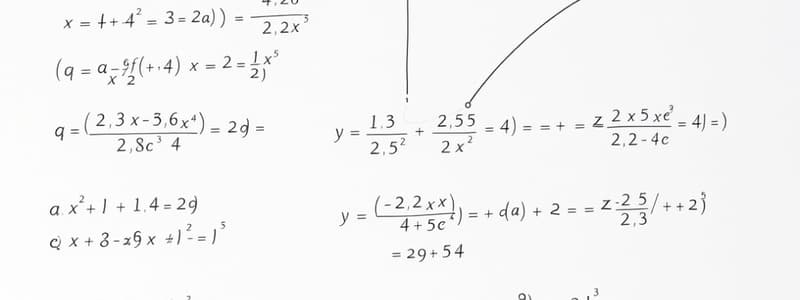Podcast
Questions and Answers
What is the term for the axis of symmetry?
What is the term for the axis of symmetry?
X=-1(b) / 2(a)
What is the equation used to solve and find the roots of a quadratic equation?
What is the equation used to solve and find the roots of a quadratic equation?
Y=-b±√(b²+4ac) / 2a
How do you find the vertex?
How do you find the vertex?
Plug into ax²+bx+c
What's special about the axis of symmetry?
What's special about the axis of symmetry?
What is the vertex?
What is the vertex?
How do you know if a parabola opens up or down?
How do you know if a parabola opens up or down?
What are the roots?
What are the roots?
What are the three outcomes of the discriminant?
What are the three outcomes of the discriminant?
What do the variables stand for in h=-16t²+vt+s?
What do the variables stand for in h=-16t²+vt+s?
Flashcards are hidden until you start studying
Study Notes
Quadratic Functions and Parabolas Study Notes
-
The axis of symmetry for a quadratic function can be calculated using the formula: ( x = -\frac{b}{2a} ).
-
The equation to solve and find the roots of a quadratic equation is given by the quadratic formula: ( y = \frac{-b \pm \sqrt{b^2 - 4ac}}{2a} ).
-
To find the vertex of a quadratic function represented as ( ax^2 + bx + c ), substitute the ( x ) value back into the equation to get the corresponding ( y ) value.
-
The axis of symmetry ensures that both sides of the parabola are mirror images; if this is not true, it indicates an error in calculations.
-
The vertex of a parabola is the minimum or maximum point located on the axis of symmetry, essential for determining the parabola's direction.
-
The direction in which a parabola opens (upward or downward) depends on the coefficient of ( x^2 ):
- If positive, the parabola opens upwards.
- If negative, it opens downwards.
-
The roots of a quadratic function represent the points where the graph intersects the x-axis, also known as the x-intercepts.
-
The discriminant of a quadratic equation determines the nature of the roots:
- Two distinct real roots when positive,
- One real root (double root) when zero,
- No real roots when negative.
-
In the formula ( h = -16t^2 + vt + s ):
- ( H ) represents the initial height,
- ( T ) indicates time,
- ( V ) is the initial velocity,
- ( S ) stands for speed.
Studying That Suits You
Use AI to generate personalized quizzes and flashcards to suit your learning preferences.




